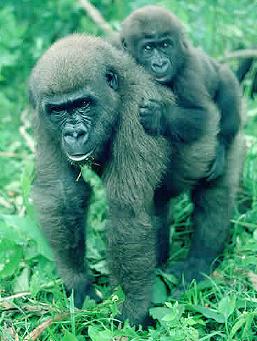|

|
Habitat
The most serious threat to gorillas is habitat loss. The rich volcanic soil of the Virungas is as highly valued as farming land. In Rwanda, Uganda and Congo, a regional conservation program stressing the importance of maintaining the virgin forest watershed and the need to habituate some groups of gorillas for tourist visits has helped ease encroachment. |
Diet
Animals of this size need a lot of food, and the vegetarian gorilla is no exception. Although they eat a variety of plants, favorites include wild celery, bamboo, thistles, stinging nettles, bedstraw and certain fruit. These plants seem to provide sufficient moisture so that gorillas do not need water.
|
 |

|
Behavior
The gorilla is shy and retiring rather than ferocious and treacherous. It usually seeks no trouble unless harassed but will valiantly defend its family group if threatened. Family groups may have up to 30 members, but even if smaller, the group usually consists of at least one older male, one or more females and a few juveniles. An adult male called a silverback named for the silvery gray hairs on its back normally leads each group, serving as its chief protector and defender. Because gorillas are nomadic, they build new nests each day at dusk, constructing them of bent branches in a tree or of grasses on the ground. Gorillas scream, grab foliage and stuff it in their mouths, stand erect on their hind legs, tear up and throw plants, drum on the chest with hands or fists, stamp their feet, strike the ground with the palms of their hands and gallop in a mock attack on all fours.
|
Predators
The gorilla's only known enemies are leopards and humans. Crocodiles are potentially dangerous to lowland gorillas. In western Africa, gorillas are commonly hunted for meat or in retaliation for crop raiding, but in eastern Africa they have been the victims of snares and traps set for antelope and other animals. Poachers have also destroyed entire family groups in their attempts to capture infant gorillas for zoos, while others are killed to sell their heads and hands as trophies.
|
|

|
Physical Description
Mountain Gorillas are one of the largest living primates Upright, the average adult male reaches 1.73 m (5 ft 8 in) in height, has an arm span of 2.29 m (7 ft 6 in) and weighs 155 kg (343 lb) (Knight 2003). Mountain Gorillas have black skin, and face, fingers, palms, and the bottoms of their feet are hairless. The rest of their body is covered with thick, black hair. The trunk is relatively short and the pelvis is wide. They have broad hands and feet, with opposable thumbs and big toes, enabling them to grasp objects with their feet as well as their hands. |
|
|
top
|